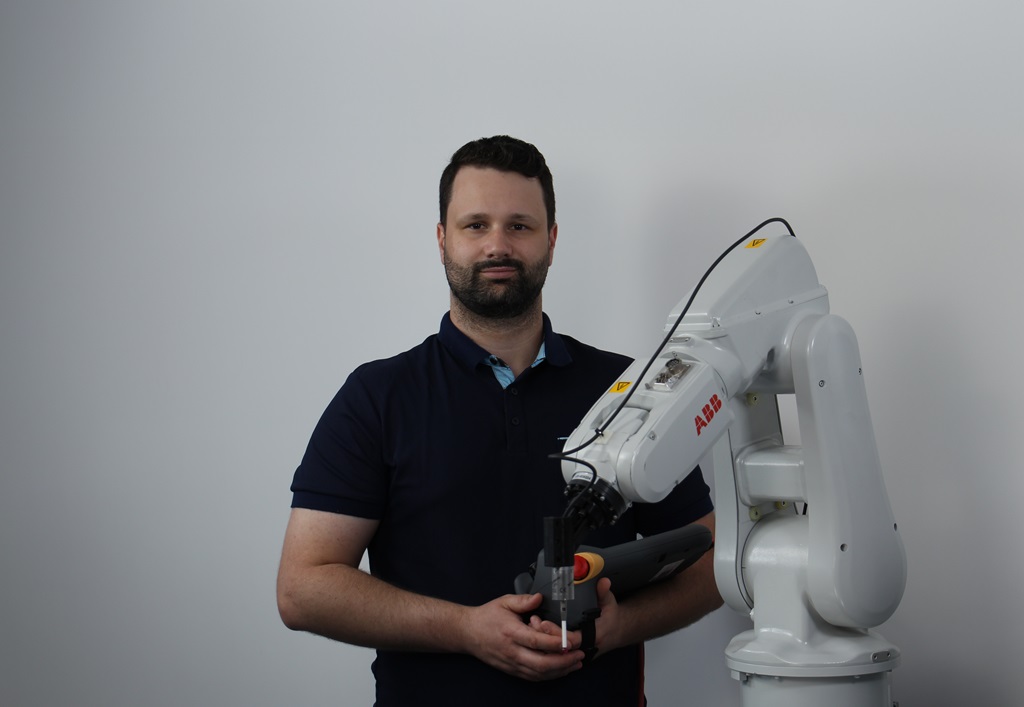In the first half of this year, there has been a range of trade shows, highlighting the rapid pace of innovation in the robotics market. Rocking Robots sat down with Samuel Bertrand to discuss trends in robotics and the effect these have on the roadmap of RoboDK.
“Part of my job is focusing on identifying the latest trends and requirements to ensure our solutions are at the forefront of developments” says Samuel Bertrand, Software Development Lead at RoboDK. Highly valuable input can be found at trade shows, such as the recent edition of Automate in Chicago. “In previous years, we were exhibitors, but this time, our focus was more on meeting partners and observing industry trends as attendees.”
“This allowed more time to explore current industry happenings and meet partners showcasing RoboDK solutions. For example, Comau, where RoboDK will be fully integrated into their next-gen RoboShop release. Mecademic also demonstrated their CAD-to-path capabilities using RoboDK for programming their robots.”
Shift
Overall, Bertrand has noticed a shift in the market over the past few years. “There is a growing focus on application-based products aimed at newcomers to robotics, particularly those with fewer than three robots. These users are often machine specialists who know their processes well but are less familiar with robotics. There are many new tools designed to make it easier for these newcomers to adopt and integrate robotics into their operations.”
And, of course, AI is on the agenda everywhere: “Over the past few decades, we have seen slow adoption at scale in the automation industry. However, with the new generation of engineers, we can see big brands starting to incorporate modern tools into their solutions. For instance, Yaskawa recently announced the addition of the NVIDIA Jetson to their next generation controller. ABB also released a OmniCore platform with scalability and future proofing in mind as well.” We can foresee off-the-shelf AI provided by manufacturers.
No Commodity
“AI is revolutionizing robotics, but we are in the early stages for industrial robotics. Because we focus on robot development, for us this is great news. Our goal is to be a platform in that revolution where you can test cases, simulate devices, train models, and test these models on real hardware, thanks to our offline programming capabilities. We want to be a platform that drives AI and robotics, enabling machinists, process experts, and newcomers to robotics with simple and easy-to-use software.” We can already feel the increase demand for our API capabilities to drive this demand.
Although language models redefined the expectation of AI, at the moment, AI in robotics is not yet a commodity for the end-user. “It has been around for a long time, but it is still something that you typically go to an integrator for to get a complete solution. You don’t necessarily have an off-the-shelf product where an engineer can trust its safety and that it will behave as intended. In the consumer market, products like ChatGPT and Copilot are now standard; even non-experts use them. In robotics, there is a lot of research and development, and in the coming years, we might see more of a robotic prompt engineer role, where you can specify tasks and robots will configure themselves accordingly. We are not yet at the point where a newcomer in robotics can use AI without realizing it because it’s simply a tool in their toolkit.”
Challenges
He positions RoboDK within the simulation and offline programming market as a very accessible solution. This also attracts a specific group of new users. “These users are usually newcomers to robotics. They often come to us with a lot of process knowledge. They know their application very well and know how to do it by hand. Their main challenges are automating the process due to labor constraints or increasing cycle time and output, or they want to complement their current processes by reducing repetitive tasks and reassigning personnel to more critical tasks.”
“These customers typically seek application-based solutions. They might be familiar with CAD/CAM software because they are machinists or CNC experts, but they don’t know how to work with robots. That is why we have plugins for CAD/CAM software like Fusion 360, FeatureCAM, SolidWorks, BobCAD-CAM, and Mastercam, allowing for quick setups and direct integration with RoboDK. One of our strengths is to provide as many entry points as possible so newcomers can find something familiar and incorporate RoboDK into their workflow. We focus on providing tools for experts to build their processes rather than claiming to be the experts ourselves.”
Accuracy
“In the short term, we are focused on continuous improvement of our current offerings. The market’s growing demand for accurate, repeatable robotic systems is a major driver. Many newcomers to robotics face challenges in defining their work frame accurately. They quickly realize that while robots are highly repeatable, they often struggle with precision. Traditional robotic calibration methods can be complex and frustrating. We work on solutions to address this by leveraging the robot’s own accuracy to define the workpiece precisely. This simplifies the process and increases efficiency.”
Also, the ability to recover quickly from crashes or changes without needing extensive recalibration is crucial. “Probing technology allows for quick recovery sequences, reducing downtime and eliminating the need for engineers to reteach all the points. This capability can be a significant selling point for manufacturers looking to minimize production interruptions and maintain high production throughput.”
He concludes: “In the long term, our goal is to fully integrate CAD/CAM/OLP functionalities into RoboDK. This will allow users to perform complex manipulations and feature extractions within the software, making it a comprehensive tool for robotics and automation. We aim to make RoboDK not only a powerful tool for simulation and offline programming but also a versatile platform for developing advanced robotic applications.”

